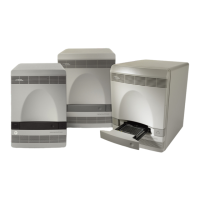Chapter 2 Designing an RQ Experiment
Specifying the Components of an RQ Experiment
10 Applied Biosystems 7300/7500/7500 Fast Real-Time PCR System Relative Quantification Getting Started Guide
Notes
Sample Experiment
In the example experiment, the objective is to compare the expression levels of several genes in the liver, kidney, and
bladder tissue of an individual. The 23 genes of interest, including ACVR1, ACVR2, CCR2, CD3D, and FLT4, are the targets
and the liver samples serve as the calibrator.
The SDS Software 1.3.1 sets gene expression levels for the calibrator samples to 1. Consequently, if more ACRV1 is in the
kidney than in the liver, the gene expression level of ACRV1 in the kidney is greater than 1. Similarly, if less CD3D is in the
bladder than in the liver, the gene expression level of CD3D in the bladder is less than 1.
Because RQ is based on PCR, the more template in a reaction, the more the PCR product and the greater the fluorescence.
To adjust for possible differences in the amount of template added to the reaction, GAPDH serves as an endogenous
control. (Expression levels of the endogenous control are subtracted from expression levels of target genes.) An
endogenous control is prepared for each tissue.
The experiment includes three sets of endogenous controls—one for each tissue. Also, the endogenous control for each
tissue must be amplified on the same plate as the target sequences for that tissue. Finally, note that the experiment uses
the singleplex PCR format, and therefore, the endogenous controls are amplified in wells different from the target wells.
Four replicates of each sample and endogenous control are performed to ensure statistical significance (see below).
Note: The example RQ experiment requires a separate plate for each of the three tissues because of the large number of
genes being studied. You can also design experiments so that several samples are amplified on the same plate, as shown
in the following table.
Singleplex Assay Multiplex Assay
In the example RQ experiment, each plate contains a
single sample type (tissue). The endogenous control for
each tissue is on the same plate as the targets for that
tissue.
If the example experiment were run with multiple sample
types on the same plate, an endogenous control for each
sample type must also be included on the same plate, as
shown here.
GR2323
Regulus
Liver_96Plate.eps
GR2323
Endogenous
controls (GAPDH)
Liver
samples
GR2324
Regulus
Kidney_96Plate.eps
GR2324
Endogenous
controls (GAPDH)
Kidney
samples
GR2325
Regulus
Bladder_96Plate.eps
GR2325
Endogenous
controls (GAPDH)
Bladder
samples
GR2322
Regulus
LivKidBladPlate.eps
Endogenous
controls (GAPDH)
Samples
Liver Kidney Bladder
GR2322

